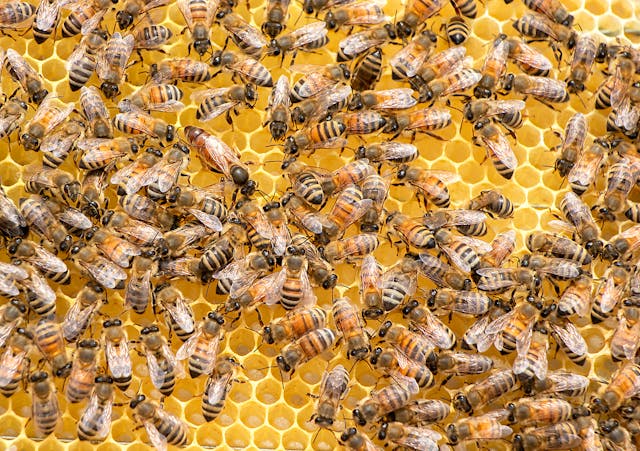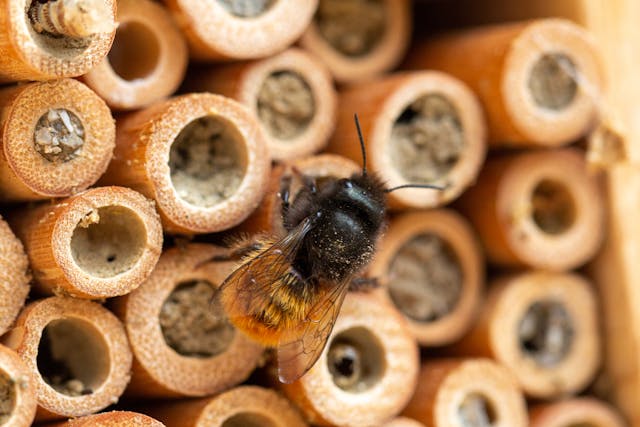A bee hotel is exactly what it sounds like: a building where lone bees may find refuge. Honeybees and bumblebees are examples of social species that live in colonies; in contrast, solitary bees build individual nests for their larvae. A significant percentage of the approximately 4,000 different species of bees that inhabit North America prefer to nest in tiny tunnels such as those offered by a bee hotel, according to Elsa Youngsteadt, an assistant professor at North Carolina State University.

Bees that are alone in the spring become industrious nest builders. After placing one egg in a tunnel and filling it with pollen, they shut the passage. They keep doing this until the tube is completely lined with egg chambers, where the larval bees will stay until the next spring or summer.
Rufus Isaacs, a professor at Michigan State University, assures us that solitary bees are safe to have in our yards and that we shouldn’t be afraid of them. They’re also great pollinators, which will improve your garden’s health and yield.
Purchasing versus Constructing a Bee Hotel
A bee motel may be built or purchased. Make a good choice if you purchase one. Youngsteadt notes that “one of the common problems I see in some of the commercially available ones is that the tunnels have a really big diameter and are very short from front to back.” Bees need a back wall for nesting, so if you’re looking for a bee hotel, make sure it includes tunnels that are 6 to 8 inches long and closed at one end, she suggests. Additionally, stay away from motels with pinecones and large-diameter tunnels since bees won’t nest there.
Construct a bee motel of your own for a more practical method. There are several different types of bee hotels. The birdhouse design is akin to a birdhouse with detachable tunnels within. A solid wood block with holes bored into it is known as the wood block style.
The Recipe for a Bee Hotel
Use a range of tunnel widths, from 1/16 to 1/2 inch, for birdhouse-style bee hotels to draw in a variety of bee species. Because bamboo naturally occurs in a variety of sizes, it is perfect for tunnels. Section the bamboo and arrange it within the motel. A number of sites provide free, comprehensive blueprints for building bee hotels in the form of birdhouses at home, such this one from North Carolina State University.
Use drill bits with varying sizes between 3/32 and 3/8 inches in diameter to make holes that are partially through for wood block-style motels, guaranteeing a closed back. At your neighborhood hardware shop, you can get extra-long drill bits that are appropriate for deeper bee hotels.

Installation Advice
For bee hotels, the location is crucial. To catch the early light, position your accommodation in a bright area facing east or southeast. The warmth will enable bees to rise early in the morning.
Additionally, bee hotels need to be fixed to a sturdy surface, such a wall of a house or shed or a fence post. Do not suspend the bee hotel from swinging limbs of trees. Put the bee hotel in place at eye level. It is simple to handle and out of the way of tiny animals, children, and pets at this height, according to Isaacs.
Lastly, avoid using pesticides near your bee motel. The creatures you are attempting to assist shouldn’t suffer any harm.
Advice on Keeping a Bee Hotel in Shape
One important but sometimes disregarded component of bee hotels is maintenance. Youngsteadt says, “You can’t just set it and forget about it.” The accumulation of parasites and illnesses is avoided by regular cleaning. Nesting material should be changed or cleaned every two to three years. Isaacs continues, “Nobody wants to live in a messy hotel.”
Since a bee motel is seldom vacant, scheduling its cleaning is difficult. In the spring, bees deposit their eggs, which may not hatch until the summer or spring after. Because doing so would harm larval bees, you cannot simply clean or discard all of the tunnels every autumn or spring. Using an emergence box is advised by the experts to prevent this problem.

An emergence box is essential to the operation of bee hotels. It is made out of a single-exit hole in a dark box that is used to store used nesting material until the larval bees have had time to hatch. In late winter or early spring, place used nesting material into the emergence box. Later that spring and summer, when the bees hatch, they will fly out of the box and into the light.
Wood blocks are very difficult to clean. To make maintenance easier, Youngsteadt recommends lining the tunnels with paper. After the bees hatch, remove these liners. You would most likely need to replace the wood block motel every few years if you don’t use this technique.
Winterization of a Bee Hotel
It’s fine to keep your emergence box and bee hotel outside in the winter as bees normally hibernate outside. Relocating them into a warm or heated space might cause the bees to emerge from hibernation earlier than necessary.
Creating Natural Nesting Habitat
A fun approach to help bee populations is by building bee motels. On the other side, if you’d like take a less involved method, provide a natural nesting area. To safeguard hibernating bees, postpone spring garden maintenance and leave dead wood and dry plant stems in situ. Solitary bees naturally nest in hollow plant stems or cavities in dead wood. By doing this, you lessen your burden and support the local bee population.
Recall that patience is essential. “Don’t give up if you don’t see bees throughout the first season. It could need some time, adds Isaacs. Allow the bees in your area some time to explore and use the newly created habitat. You can make your garden a flourishing haven for these important pollinators with patience and attention.



